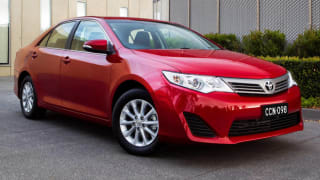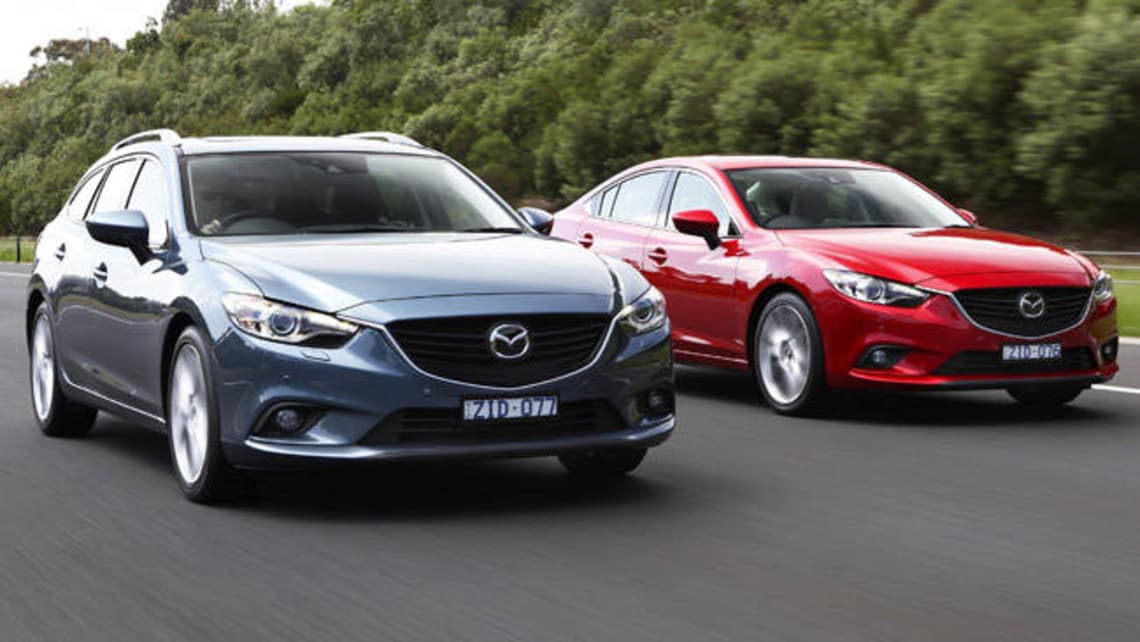
Toyota Camry Altise 2012 Review
Tell people you drive a Camry and they look down their nose at you.
Browse over 9,000 car reviews

If you want to know the difference between a small SUV and a medium SUV, multiply the length of the vehicle by its width.
The categories are split by footprint. Above a certain size, it's medium. Of course, you don't need to know. You just need to find one that suits you. It does help to build a shopping list, though, and for the industry some sort of scheme is essential.
Most commonly used is a system based on letters. A “C-segment” car means the Toyota Corolla and its rivals. B is smaller, D is larger, and so on. US makers remain fond of terms such as “compact” and “sub-compact” but have started to adopt the alphabet. Here, we're still hooked on small, medium and large.
Not all divisions are as scientific as the SUV one mentioned above. The divide between medium and large cars is becoming increasingly fuzzy. Take the locally made Toyota Camry and Aurion. The Camry has a four-cylinder engine and the Aurion a six, but they are the same car.
However, the Camry is categorised as mid-size while Aurion is large. Cynics say Toyota has gamed the system so it can offer the Aurion as a rival for the Holden Commodore and Ford Falcon, but the two Toyotas should be in the same category.
But which one? What Toyota has really done is expose the fact the two categories may as well be merged into one, so close are the cars on size and so arbitrary is the distinction between them. The divide is political rather than dimensional. When Ford began importing the Mondeo a few years ago, the Mondeo was put in the medium category so that it didn't compete against the Falcon.
The two are very similar in length, though, and in reality they are rivals. Holden will do a similar thing when it begins importing the Malibu later this year; it goes in the medium class despite being only a whisker shorter than a Commodore.
Truth is, the offerings are multiplying but buyers have moved on. Ten years ago, large and medium combined cornered one-quarter of the market. Since then, they have lost more than 10 percentage points of market share -- about 110,000 buyers a year -- between them.
Medium cars outsold large for the first time last year, but no one is celebrating. They are like two semi-detached dwellings, sharing a dividing wall. And there's a plague on both their houses. The Mazda 6, launched late last year, embodies many of these contradictions. Previously available as hatch, sedan or wagon, the popular hatch -- which offered something unique at this level -- has been dropped.
Even odder, the sedan has grown to become easily long enough to be in the large category while the wagon, although still long, is actually shorter. The 6 has started strongly, with almost 1500 sold in the first two months. In a combined medium-large category it would be fourth, hot on the tail of the Falcon but behind the Camry-Aurion and Commodore.
However, the 6 has little prospect of returning to the levels of the second generation, which averaged more than 7700 buyers a year across its life. And no chance at all of replaying the glory days of the first 6 from 2002, when 13,000 a year were bought. The strange sedan-wagon strategy won't help. It has little to do with Australia and more to do with maximising the 6's prospects in global markets.
VALUE
From $33,460 (Sport sedan 2.5) prices start just above the Camry, Mondeo and Hyundai i40, but above European offerings such as the Volkswagen Passat. All grades get Bluetooth, USB connector, reversing camera and push-button start, with parking sensors missing only from the entry model. GT and Atenza trims get 19-inch alloys instead of 17s, keyless entry, intelligent headlamps and a sunroof.
TECHNOLOGY
It comes in four trim grades, offers petrol and diesel four-cylinder engines, both with a six-speed automatic transmission. This car brings together Mazda's awkwardly named Skyactiv technology, which is the collective for an efficiency program that includes lightweight construction, electric power steering, idle-stop and, for the first time in a Mazda, regenerative brakes (with the even clumsier name of i-Eloop).
DESIGN
They are both sold as medium, in case you're wondering. Australians still shopping for traditional shapes could do worse than a 6, though. The design is a return to form for the brand, after some less convincing shapes such as the BT50 ute. It's handsome and appealing. Interior space is more than adequate, especially in the sedan with its 8cm longer wheelbase than the wagon, and seats split-fold into a 438-litre cargo area (451 wagon).
The cabin presents a quality first impression, with a soft dash-top, gloss black finishes and weighty metallic rotary knobs for the airconditioning. As in other Japanese cars, the cabin coherence is let down by a profusion of screens, each with its own appearance and fonts.
SAFETY
The Atenza is the only one with a full suite of safety kit, including intervention braking and blind spot warning system.
DRIVING
Both engines are worth a look, with the 2.5 petrol up a bit on power. While snap acceleration shouldn't be expected and its soundtrack won't melt any petrol-head hearts, it's a nice, easygoing match for the car. The automatic transmission could be quicker to change or kick down and it felt like a better fit with the diesel.
I liked the diesel more than I expected. It gives the car a driveable quality as it pulls strongly and revs quickly -- but not pointlessly -- to 5500rpm. It's unmistakably a diesel, emitting growly low notes, but without the awful clatter that some make.
The chassis is a highlight too, in both body shapes, and the car tips into corners feeling nicely controlled and well-damped. This 6 has been criticised for losing some of the dynamic crispness of the previous car but its mass is modest for its size -- the Atenza wagon is the heaviest at 1526kg -- and this translates into a feeling of lightness on the road.
Where the accusation holds is the steering, which points well but is less direct, with a little looseness around the centre. Other downsides include more road and tyre noise than ideal, some restrictions to over-the-shoulder vision from pillars and headrests, and very ordinary AM radio reception.
In the wagon, the cargo floor seems artificially high. The overall ride quality is composed, but sharp edges send abrupt jolts into the cabin. All of which, taken together, would not be a deal-breaker.
VERDICT
The 6 is one of the more convincing new arrivals at this level and against its rivals -- medium or large -- it's a contender.
MAZDA6
Vehicle: Mid-size sedan or wagon
Engines: 2.5-litre four-cylinder petrol or 2.2-litre turbocharged four cylinder diesel
Outputs: 138kW at 5700rpm and 250Nm at 3250rpm (2.5); 129kW at 4500rpm and 420Nm at 2000rpm (2.2)
Transmission: Six-speed automatic, front-wheel drive
Fuel: 6.6l/100km combined (2.5, 91RON); 5.4l/100km (2.2)
Price: from $33,460 (Sport sedan 2.5) to $50,960 (Atenza wagon 2.2) plus on-road costs
| Vehicle | Specs | Price* | |
|---|---|---|---|
| Sport | 2.5L, —, 6 SP AUTO | $10,890 – 14,960 | 2013 Mazda 6 2013 Sport Pricing and Specs |
| Sport | 2.5L, —, 6 SP AUTO | $11,110 – 15,180 | 2013 Mazda 6 2013 Sport Pricing and Specs |
| Touring | 2.5L, —, 6 SP AUTO | $12,760 – 16,940 | 2013 Mazda 6 2013 Touring Pricing and Specs |
| Touring | 2.5L, —, 6 SP AUTO | $12,540 – 16,720 | 2013 Mazda 6 2013 Touring Pricing and Specs |
$9,890
Lowest price, based on 139 car listings in the last 6 months